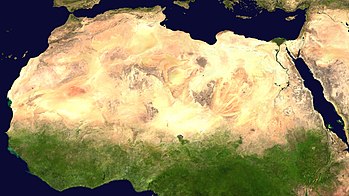
Back الحقبة الإفريقية الرطبة Arabic Periodo húmedo de África Spanish دوره پربارش نوسنگی Persian Période humide africaine French התקופה הלחה באפריקה HE Periode Afrika basah ID Periodo umido africano Italian Африканський вологий період Ukrainian

The African humid period (AHP; also known by other names) is a climate period in Africa during the late Pleistocene and Holocene geologic epochs, when northern Africa was wetter than today. The covering of much of the Sahara desert by grasses, trees and lakes was caused by changes in the Earth's axial tilt; changes in vegetation and dust in the Sahara which strengthened the African monsoon; and increased greenhouse gases. During the preceding Last Glacial Maximum, the Sahara contained extensive dune fields and was mostly uninhabited. It was much larger than today, and its lakes and rivers such as Lake Victoria and the White Nile were either dry or at low levels. The humid period began about 14,600–14,500 years ago at the end of Heinrich event 1, simultaneously to the Bølling–Allerød warming. Rivers and lakes such as Lake Chad formed or expanded, glaciers grew on Mount Kilimanjaro and the Sahara retreated. Two major dry fluctuations occurred; during the Younger Dryas and the short 8.2 kiloyear event. The African humid period ended 6,000–5,000 years ago during the Piora Oscillation cold period. While some evidence points to an end 5,500 years ago, in the Sahel, Arabia and East Africa, the end of the period appears to have taken place in several steps, such as the 4.2-kiloyear event.
The AHP led to a widespread settlement of the Sahara and the Arabian Deserts, and had a profound effect on African cultures, such as the birth of the Ancient Egyptian civilization. People in the Sahara lived as hunter-gatherers and domesticated cattle, goats and sheep. They left archaeological sites and artifacts such as one of the oldest ships in the world, and rock paintings such as those in the Cave of Swimmers and in the Acacus Mountains. Earlier humid periods in Africa were postulated after the discovery of these rock paintings in now-inhospitable parts of the Sahara. When the period ended, humans gradually abandoned the desert in favour of regions with more secure water supplies, such as the Nile Valley and Mesopotamia, where they gave rise to early complex societies.
© MMXXIII Rich X Search. We shall prevail. All rights reserved. Rich X Search